Lipids and Membranes
1/74
There's no tags or description
Looks like no tags are added yet.
Name | Mastery | Learn | Test | Matching | Spaced |
|---|
No study sessions yet.
75 Terms
What are lipids?
Non-polar organic compounds
Not soluble in water
Highly soluble in non-polar organic solvents e.g. chloroform
3 main biological functions of lipids
Membrane formation
Energy storage
Precursors to signalling molecules
What is the principal component of most lipids?
Fatty acids
Structure of fatty acids
Carboxylic acid
» polar, hydrophilic
Unbranched hydrocarbon chain
» non polar, hydrophobic
» can be saturated or unsaturated
» between 14 to 22 Cs long
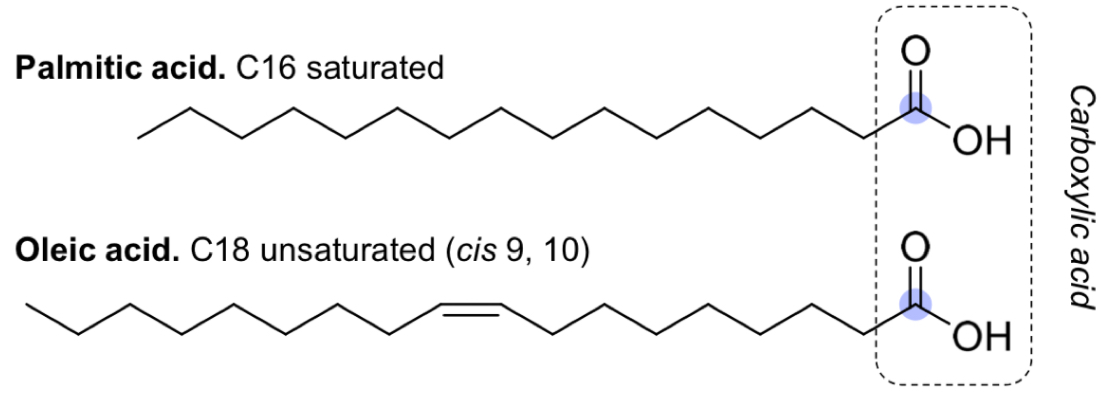
What determines the physical properties of a fatty acid and therefore its biological function?
The length of the hydrocarbon chain
The degree of unsaturation
How are chemical structure, physical property and biological function of a molecule linked?
Chemical structure —> Physical properties —> Biological function
Draw the structures of stearic acid, oleic acid and linoleic acid
What is the similarities and differences between these fatty acids?
All C18 lipids (contain 18 C atoms)
Contain different numbers of C=C bonds
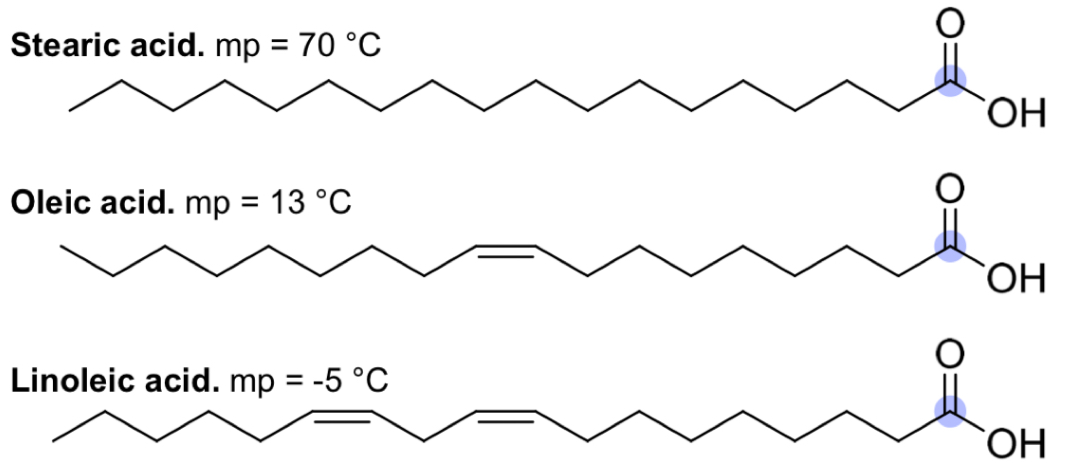
Why is the number of C=C bonds a fatty acid has important?
Affects the melting point
As the number of C=C bonds increases, the melting point of the lipid decreases
Melting point of fatty acids
Saturated fatty acid over 8 Cs long = melting point over 25, solid at room temp
Saturated fatty acids 8 Cs or less and unsaturated fatty acids = melting point below 25, liquid at room temp
State whether stearic acid, oleic acid and linoleic acid are solid or oil at room temp
Stearic acid (saturated) = solid
Oleic acid (unsaturated) = oil
Linoleic acid (unsaturated) = oil
Why do unsaturated fatty acids have a lower melting point?
When an alkene is present in a fatty acid, geometric isomerism occurs (can be cis or trans isomer)
Most unsaturated fatty acids are found in the cis conformation
The presence of cis alkenes means that the hydrocarbon chains are not straight chains occupying minimal space
Instead, they are bulky and the cis alkenes cause the hydrocarbon chain to bend
More double bonds = more bending
Bent = hydrocarbon chains unable to pack together as tightly = fewer hydrophobic interactions = lower MP
Why do saturated fatty acids have a higher melting point?
Hydrocarbon chain adopts a linear conformation
This means it can pack more closely together with neighbouring molecules
This allows more hydrophobic interactions to form = higher MP
Why is it important that the fatty acids in membranes are unsaturated?
Fatty acids cannot pack together as closely
This leads to a membrane which can move more freely
Increasing membrane fluidity
What are polyunsaturated fatty acids?
Fatty acids with more than one C=C double bond
Why are polyunsaturated fatty acids important in the diet?
Precursors for biosynthesis of important signal molecules e.g. arachidonic acid is a precursor for prostaglandins
These signalling molecules are hormones which control blood flow and smooth muscle contraction

Why are polyunsaturated fatty acids known as essential fatty acids?
We cannot synthesise them in the body - we need to obtain them from the diet
2 types of polyunsaturated fatty acids
Omega-3 (first double bond occurs 3 carbons from the end of the chain)
Omega-6 (first double bond occurs 6 carbons from the end of the chain)
What type of polyunsaturated fatty acid is arachidonic acid
Omega-6
Types of lipids
Triacylglycerols AKA Triglycerides
Phospholipids
Cholesterol
Triacylglycerols (Triglycerides)
Main function
Energy storage
Fatty acids are storied as triacylglycerols in fat cells, and then are released by hydrolysis when needed for energy production
Triacylglycerols (Triglycerides)
How are they formed?
3 fatty acids + 1 glycerol
In a condensation reaction
Forms 3 ester bonds
Loses 3 molecules of water
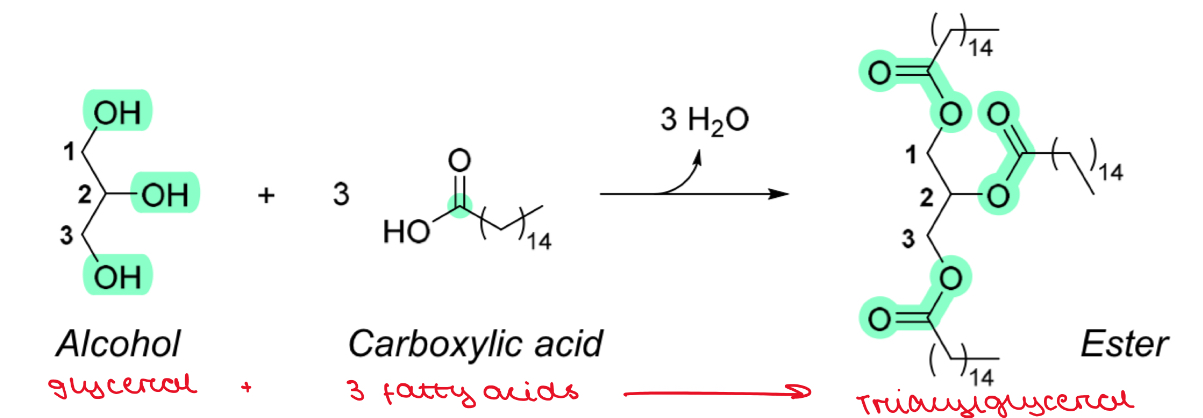
Triacylglycerols (Triglycerides)
2 types
Fats
Triacylglycerols which are solid at room temp (saturated with more than 8 Cs)
Common in animals e.g. butter
Oils
Triacylglycerols which contain more unsaturated fatty acids = liquid at room temp
Common in plants e.g. olive oil
Phospholipids
Why are phospholipids the most important structural lipids?
They are the main component of biological membranes
Phospholipids
What does it mean by phospholipids are amphipathic?
Contain both hydrophobic and hydrophilic regions in the same molecule
Polar hydrophilic head group
Non-polar hydrophobic lipid tails

Phospholipids
Structure
2 fatty acids + glycerol + phosphate group
In a condensation reaction
The phosphate group is linked to a small polar group e.g. choline, serine, ethanolamine
The hydrophobic tail is formed from 2 fatty acids which are linked via ester bonds to the glycerol
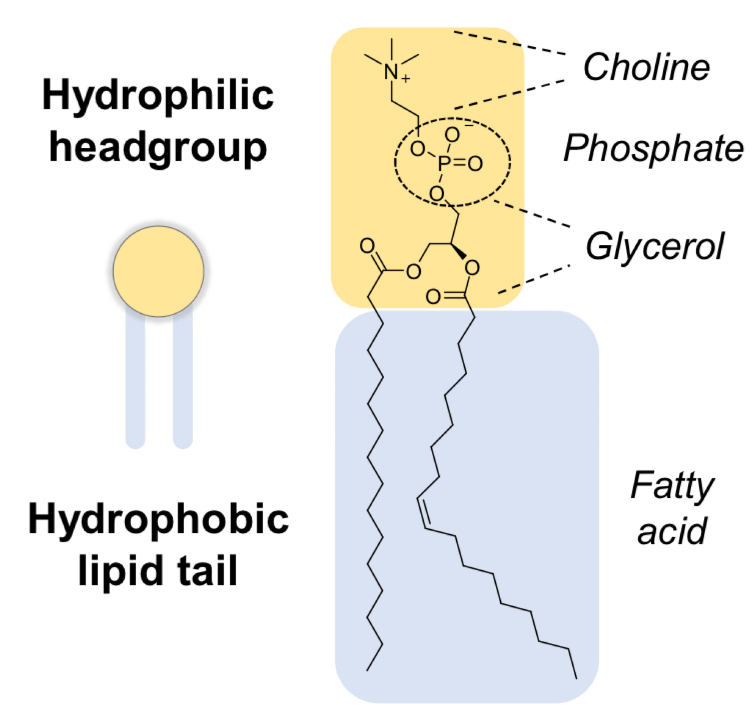
Phospholipids
What does the head group determine?
The head group determines the overall charge of the phospholipid
Phospholipids can be positive, negative or neutral
This influences the overall charge of cell membranes
Cholesterol
Structure
Multicyclic hydrocarbon with 4 rings and a short alphatic chain
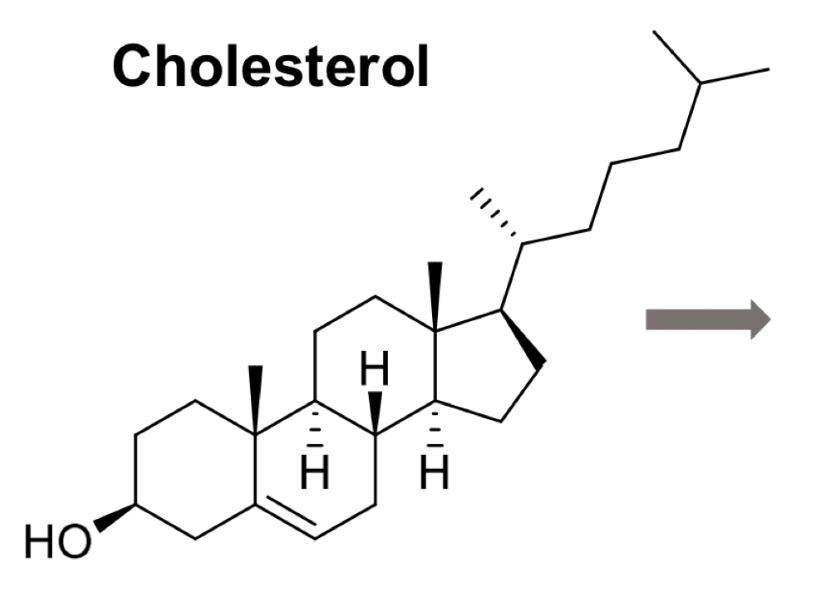
Cholesterol
How is cholesterol obtained?
From the diet
Synthesised in the liver
Cholesterol
Role of cholesterol
Increases membrane fluidity » this allows the membrane to move to fix itself
Biosynthetic precursor to many important biology molecules:
E.g. Vitamin D, which is important for calcium absorption from the diet
E.g. Bile acids like cholic acid, which emulsify fats in digestion
E.g. Steroid hormones, like testosterone and progesterone
Other types of complex lipids
Waxes
Sphingolipids
Glycolipids
Waxes
Structure?
Where are they found?
Complex mix of different lipids
Each lipid has a simple structure with a single ester
Contains saturated fatty acids
Found in the waterproof coating of organisms
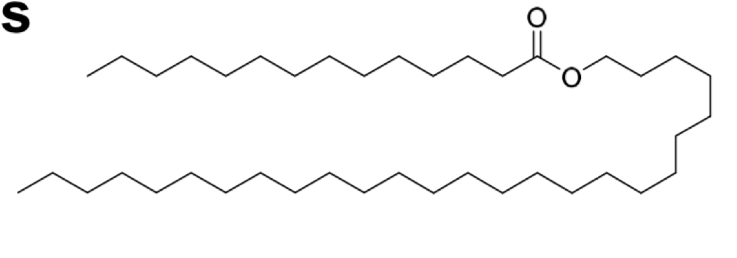
Sphingolipids
Where are they found?
What is their function?
Found in all eukaryotes, associated with membranes
They protect the external cell surface by increasing mechanical stability of the membrane
This helps membranes to repair themselves

Glycolipids
Structure
Where are they found?
What is their function?
Lipid molecules associated with sugar molecules, like cerebroside
Found on cell surfaces
Involved in cell recognition and signalling
What concept is linked to membranes?
Compartmentalisation
Lipid membranes create compartments which are essentially for cell survival
This allows organelles to be kept separate from the rest of the cell
Membranes are not just passive barriers, they are an active part of the cellular machinery
Role of membranes
Provides structure
Controls the amount of nutrients, preventing compounds the cell requires from leaking out
Controls the internal conditions of each compartment » so controls which reactions can occur
Controls which molecules come in and out of each compartment » brings in nutrients and removes waste
Allow cellular communication » allow cells to send and receive signals from other cells via cell surface receptors
Why is it important that organelles have their own membranes?
Keeps them separate from the rest of the cell. This is called compartmentalisation
This means different processes can happen within the cell at the same time
E.g. Metabolism
Catabolism and anabolism need to be kept separate for the cell to function properly
Lysosomes contain digestive enzymes to break down waste macromolecules
These enzymes need to be separated from the cytoplasm so the cell can synthesis new macromolecules without them being immediately digested
Compartmentalisation of digestive enzymes in lysosomes therefore allows the cell to simultaneously break down macromolecules and synthesise new ones
Give an example of how membranes can allow cellular processes to occur
Mitochondria have a double membrane
ATP synthesis is carried out by proteins on the inner mitochondrial membrane
The membrane provides the ideal compartment and a large surface area for this reaction to occur
What is the main component of lipid membranes?
Phospholipids
How do phospholipids form a structure such as the lipid membrane?
The amphipathic nature of phospholipids cause them to self-assemble when they are in aqueous environments
So that the hydrophilic heads are on the outside and the hydrophobic tails are on the inside
This structure is held together by hydrophobic interactions between the fatty acid tails and the attraction between the polar head groups and water » there are no covalent interactions, only non-covalent
What are the different types of self-assembled structures that phospholipids can form?
Micelles
Single layer of lipids with hydrophobic tails inside and hydrophilic heads outside which associate with water
Formed by phospholipids with a one fatty acid tail
Phospholipid bilayers
Hydrophobic tails inside and hydrophilic heads outside which associate with water
Formed by phospholipid with two fatty acid tails
Liposomes
Spherical structures
Formed from a lipid bilayer which has self-sealed
Have a hollow aqueous cavity in their centre which can be used for drug delivery
E.g. use of liposomes for delivery of mRNA for Covid-19 vaccines

Characteristics of phospholipid bilayer
Fluid
Lipids in the bilayer are able to move freely
This makes the bilayer flexible and means they are able to reseal if damaged
Impermeable to water and polar compounds e.g. sugars and amino acids
This is because the centre of the bilayer is extremely hydrophobic and does not allow polar molecules to cross
This prevents the leakage of essential nutrients
Permeable to small, uncharged, lipid soluble compounds e.g. oxygen, carbon dioxide, nitrogen, glycerol, urea, steroids
Permeable to water via special transmembrane protein channels called aquaporins
This allows the cell to regulate osmotic pressure
Why is the plasma membrane being impermeable to polar compounds a problem?
Means that essential nutrients and ions required by the cell cannot pass through the bilayer
So the cell membrane requires transport proteins for these molecules
Define fluidity
How much the components of a membrane can move
What does the fluidity of a membrane depend on?
The structure of the lipids it contains
Saturated fatty acids pack more tightly together = form dense bilayers = more rigid = less fluid
Shorter fatty acids OR unsaturated fatty acids cannot pack as closely together = form a looser bilayer = more fluid
The amount of cholesterol in the membrane
Cholesterol disturbs the bilayer by disrupting the packing of fatty acids = increases fluidity
Why are membranes in animals and plants fluid?
They are rich in unsaturated fatty acids
They contain a high proportion of cholesterol
Importance of fluidity in membranes
Allows membranes to heal and fuse with each other
E.g. vesicles can form from the membrane allowing the transport or secretion of materials
What mode is used to explain what a membrane bilayer looks like?
The fluid mosaic model
Describe the fluid mosaic model
The plasma membrane consist of:
Lipids » contain unsaturated fatty acids
Carbohydrates on the outer surface » can be protein linked (glycoproteins) or lipid linked (glycolipid)
Proteins » the lipid:protein ratio can vary from 1:4 (e.g. in mitochondria) to 4:1 (e.g. in myelin sheath)
These molecules move sideways within the membrane
The ‘mosaic’ is held together by non-covalent interactions between lipids and proteins
2 types of membrane proteins
Integral » embedded in the bilayer
Peripheral » loosely attached to one face of the membrane, either associated to integral proteins or to the bilayer itself
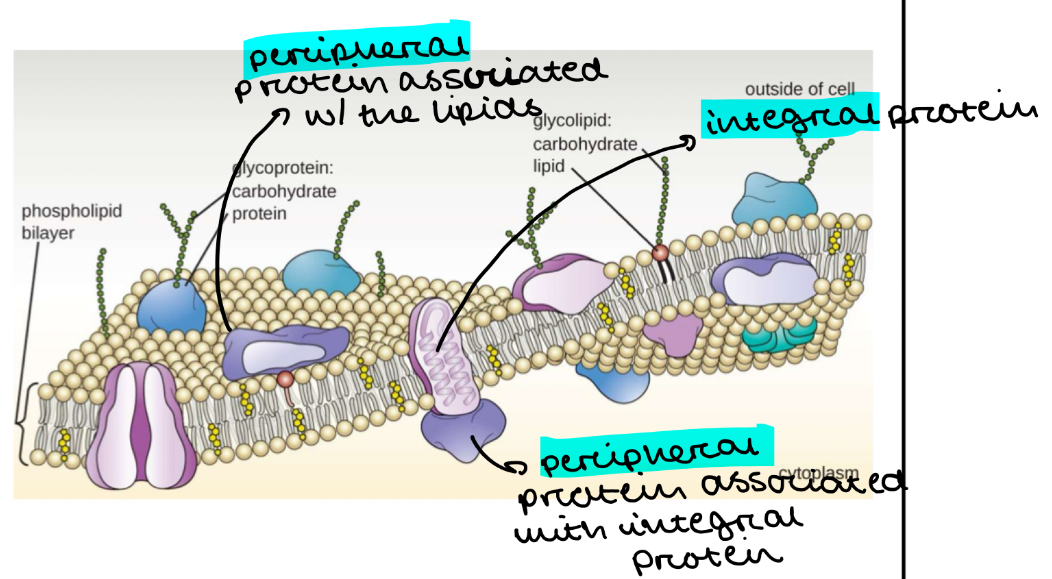
What are integral proteins which span the whole bilayer referred to as?
Transmembrane proteins
» part of the protein is on the inside and the outside of the membrane
How can integral proteins only be removed?
By disruption of the membrane by detergents
How can peripheral proteins only be removed?
By mild changes in pH or ionic strength
Structure of membrane proteins
Have hydrophobic regions which associate with the fatty acid tails of the phospholipid bilayer
Have hydrophilic regions e.g. polar amino acids which will protrude from the membrane into the aqueous environment
What is the structure of glycoproteins?
What is their function?
Have sugars bound to either Ser or Asp residues on the hydrophilic portion of the protein protruding from the outer leaflet of the bilayer
These glycoproteins act as antigens by which cells are recognised as host cell rather than a foreign cell
What does it mean by biological membranes being asymmetric?
There are physical and biochemical differences between the inner leaflet (face of the bilayer in contact with the cytoplasm( and outer leaflet (face of the bilayer in contact with outside of cell/organelle)
How do lipids move within the bilayer?
Lipids diffuse sideways within the leaflet
But there is a high energy to transfer lipids from one side of the bilayer to the other (lipid flip-flop)
Do lipids and proteins change their orientation in the bilayer?
Lipids: yes, can diffuse sideways
Proteins: no, as their direction is important for their function e.g. signalling receptors must have the hormone-binding domain facing the outside of the cell to receive signals
How does a cell allow the movement of polar molecules across the bilayer?
Using transmembrane proteins e.g. channels, pumps, gates
These are big proteins which pass all the way through the bilayer, allowing polar compounds to pass through the middle of the protein without coming into contact with the fatty acid tails
How does a cell take up or excrete large molecules or large quantities of compounds?
Endocytosis
Exocytosis
Membrane Transport
Passive Diffusion
Transfer of solutes/ions down their concentration gradient
No energy from ATP required
Can occur across the lipid membrane OR via channels such as aquaporins
Facilitated passive diffusion transports large/charged/polar molecules and occurs via a carrier protein
Membrane Transport
Active Transport
Solutes/ions transported against their concentration gradient
Requires metabolic energy from ATP hydrolysis
The energy from ATP is used by carrier proteins to pump a molecule from one side of the membrane to the other
Carrier proteins have 2 binding sites: 1 for ATP, 1 for the solute
Membrane Transport
Gated Channels
Most channels are not permanently open and have a gate which controls the opening and closing of the channel
This is so the membrane can regulate when certain molecules are able to enter or exit
2 types:
Ligand-gated ion channels » channel opens in response to the binding of a particular molecule e.g. nicotinic acetylcholine receptors need to bind acetylcholine to allow the passage of ons through the channel
Voltage-gated ion channels » channel opens in response to a change in membrane potential e.g. ion channels in nerve cells
Types of carrier proteins
Uniporters: transport only 1 type of solute in one direction across the membrane
Co-transporters: transport 2 different solutes, so that the transport of one solute is coupled with the transfer of a second solute
Types of carrier proteins
Co-transporters
Transport 2 different solutes, so that the transport of one solute is coupled with the transfer of a second solute
Co-transporters move 1 solute down its concentration gradient
This releases free energy which is then used to transport the second solute against its concentration gradient
2 types of co-transport:
Symporters: carry 2 solutes across the membrane in the same direction
Antiporters: transport 1 solute in one direction and a different solute in the opposite direction
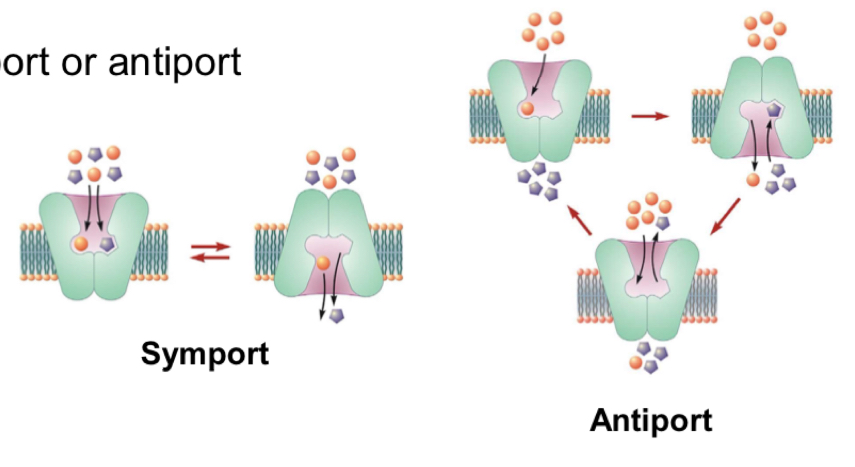
Transport of Glucose
Where does glucose need to be transported to?
Glucose carried from the intestines
Across the gut epithelium
Into the blood
Where it is carried to tissues to make energy
Transport of Glucose
Explain how glucose is transported into the blood
At the epithelial cell / blood surface, the Na+/K+ ATPase antiporter uses ATP to actively transport K+ into the epithelium and Na+ out of it
This reduces the conc of Na+ ions inside the cell
Na+ moves down its concentration gradient from the gut lumen into the cell through the Na+ glucose symporter
This provides the free energy to bring glucose into the cell from the gut lumen against its concentration gradient
The concentration of glucose increases inside the epithelial cell
So glucose moves into the blood from the epithelial cell down its concentration gradient by facilitated diffusion via a glucose uniporter
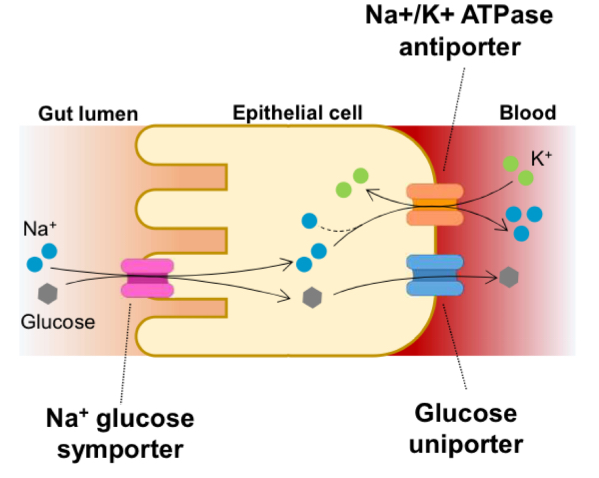
Transport of Ca2+
What channel is involved?
What is the purpose of transporting Ca2+?
Endoplasmic reticulum (ER) membranes contain Ca2+-ATPase
It pumps Ca2+ ions by active transport from the cytoplasm into the ER
This builds up a store of Ca2+ in the ER which can be released when needed for muscle contraction
Transport of Ca2+
What does the Ca2+-ATPase need to function?
Ca2+-ATPase is an active transporter
This means it requires ATP to function
Transport of Ca2+
Explain how ca2+ is transported from the cytoplasm into the ER
At first the Ca2+-ATPase channel is closed
But calcium binding sites are open on the cytoplasmic side of the channel, allowing Ca2+ to bind
ATP binds to the nucleoside binding site of the channel
ATP is hydrolysed to ADP and phosphate, releasing energy
This energy causes the conformation of the Ca2+-ATPase to change
This opens the channel, releasing the bound calcium into the ER lumen
The phosphate produced in ATP hydrolysis is hydrolysed and released from the channel
The channel reverts to its closed state, so Ca2+ can bind again
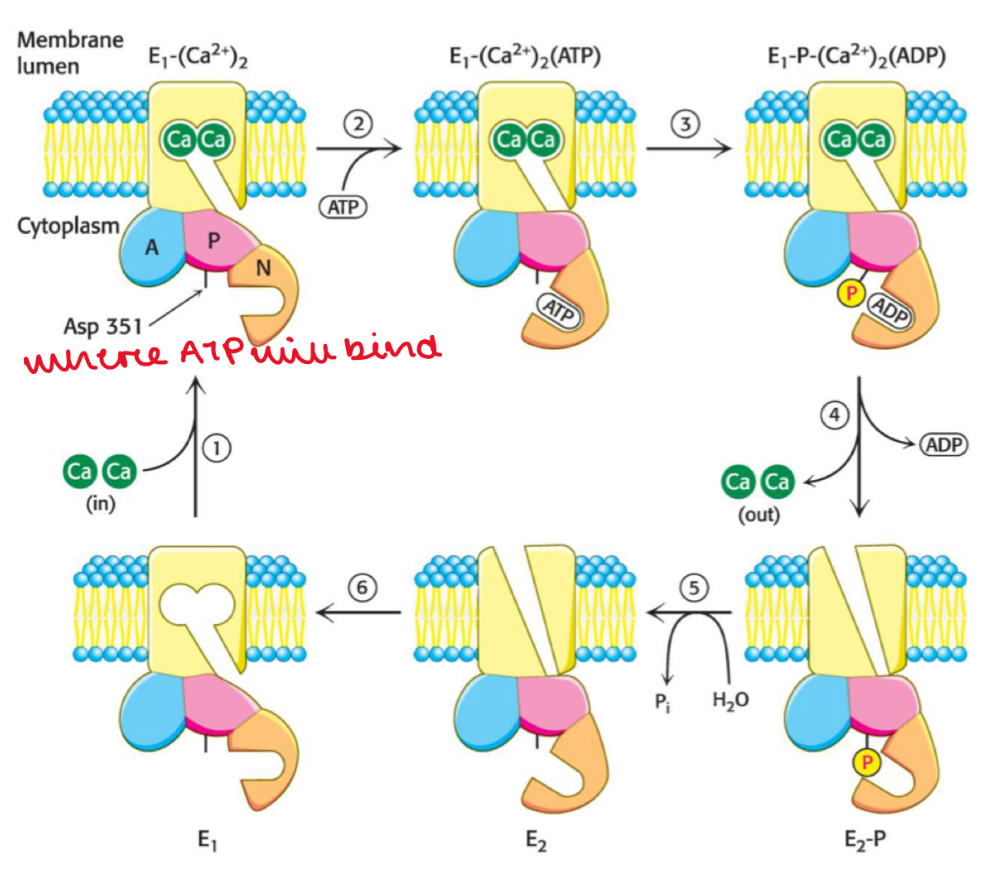
How are both endocytosis and exocytosis possible?
Because of membrane fluidity
Endocytosis
How does it work?
2 types
Bulk uptake happens via endocytosis
The membrane forms a vesicle around the particle to be taken up
Pinocytosis - describes the uptake of fluid in vesicles
Phagocytosis - describes the uptake of large particles e.g. pathogens in vesicles
Endocytosis
What is meant by receptor-mediated endocytosis?
Some molecules are selectively taken up into vesicles when they bind to a specific receptor protein on the cell surface
Endocytosis
How can the substances that enter the cell via endocytosis be digested for the use in the cell’s own metabolic processes?
Vesicles can fuse with lysosomes
Exocytosis
How does it work?
Allows cell to excrete large particles or bulk quantities of molecules
Vesicles containing particles to be excreted fuse with the membrane and release the particles into the extracellular space
Review Questions
Describe the roles and functions of lipid membranes
List the key characteristics of eukaryotic membranes. Why are these characteristics important for the function of the membrane
Summarise the main ways molecules can pass from one side of the membrane to the other. What are they key features of each route?